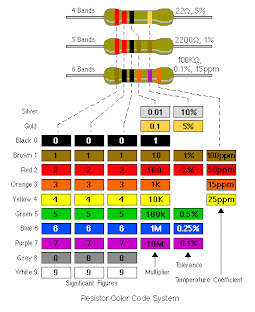Current Limiting Resistor Calculator for Leds
-
If you want to calculate Resistor, please visit Here!
Some good values to try:
As supply voltage:
For molex: 5, 7 and 12 volts
Batteries: 1.5 and 9 volts
...
8:56 PM
- The LEDs Are ON When The Phototransistors Are Dark -(The Outputs Are LOW When The Inputs Are HIGH)
The circuit on this page is for a visible and infrared light detector circuitboard that has 8 detectors. LM339 voltage comparators are the active element. These detectors can be used as part of other light detector circuits shown on other pages at this site such as these Light Activated Detector Circuits at this site.
A) Basic Inverting Detector Circuit
The following diagram shows the basic circuit on the Inverting circuitboard.

Selecting A Value For The Input Resistor (R1)
The value of resistor R1 depends on the type of sensor and the desired sensitivity. See below for more details.
For phototransistors a value of 470K ohms will work for most room light situations. If the light is dim, selecting a higher value resistor such as 1 Megohm will give better sensitivity. This High Impedance Test Voltmeter circuit can also be used for testing phototransistors installations.
For CdS photocells it is usually best to install the cell and then measure its resistance under the normal lighting conditions. A resistor with a value that is 3 to 5 times the measured resistance of the cell is then selected for R1.
Selecting A Value For The Output Resistors (R4)
The value of resistor R4 is chosen to give a desired current flow though the LEDs See below for more details.
A 1K ohm resistor will allow about 10 milliamps to flow through a typical LED if the supply voltage is 12 volts. The value of the resistors at the outputs of the comparators can changed depending on the desired current through the LEDs.
B) 8 - Photo-Detector PCB Circuit
The following diagram shows the circuit that is on the printed circuit board. There are 8 independent photo-detectors with open collector outputs that can sink up to 15 milliamps each.

Circuit Notes
i) All of the comparators on the PCB are wired so that when the photosensors are dark, the output of the comparators will be LOW and the LEDs will be ON.
ii) The detection voltage level for the circuit as shown is set at 1/2 of the supply voltage. If a lower or higher detection level voltage is needed, the values of resistors R9 / R10 and R19 / R20 can be adjusted.
iii)This circuit does not need a regulated power supply and can operate on supply voltages of up to 32 volts.
iv)The 1K output resistors can be replaced by jumper wires if they are not needed such as for inputs to control or signals circuits that have their own current limiting resistors.
v) WARNING - If the polarity of the power supply for this circuit is reversed or the circuit is connected to an AC or DC source this circuit will be damaged. The maximum supply voltage for this circuit is 15 Volts.
Please go here to see the full model!
The circuit on this page is for a visible and infrared light detector circuitboard that has 8 detectors. LM339 voltage comparators are the active element. These detectors can be used as part of other light detector circuits shown on other pages at this site such as these Light Activated Detector Circuits at this site.
A) Basic Inverting Detector Circuit
The following diagram shows the basic circuit on the Inverting circuitboard.

Selecting A Value For The Input Resistor (R1)
The value of resistor R1 depends on the type of sensor and the desired sensitivity. See below for more details.
For phototransistors a value of 470K ohms will work for most room light situations. If the light is dim, selecting a higher value resistor such as 1 Megohm will give better sensitivity. This High Impedance Test Voltmeter circuit can also be used for testing phototransistors installations.
For CdS photocells it is usually best to install the cell and then measure its resistance under the normal lighting conditions. A resistor with a value that is 3 to 5 times the measured resistance of the cell is then selected for R1.
Selecting A Value For The Output Resistors (R4)
The value of resistor R4 is chosen to give a desired current flow though the LEDs See below for more details.
A 1K ohm resistor will allow about 10 milliamps to flow through a typical LED if the supply voltage is 12 volts. The value of the resistors at the outputs of the comparators can changed depending on the desired current through the LEDs.
B) 8 - Photo-Detector PCB Circuit
The following diagram shows the circuit that is on the printed circuit board. There are 8 independent photo-detectors with open collector outputs that can sink up to 15 milliamps each.

Circuit Notes
i) All of the comparators on the PCB are wired so that when the photosensors are dark, the output of the comparators will be LOW and the LEDs will be ON.
ii) The detection voltage level for the circuit as shown is set at 1/2 of the supply voltage. If a lower or higher detection level voltage is needed, the values of resistors R9 / R10 and R19 / R20 can be adjusted.
iii)This circuit does not need a regulated power supply and can operate on supply voltages of up to 32 volts.
iv)The 1K output resistors can be replaced by jumper wires if they are not needed such as for inputs to control or signals circuits that have their own current limiting resistors.
v) WARNING - If the polarity of the power supply for this circuit is reversed or the circuit is connected to an AC or DC source this circuit will be damaged. The maximum supply voltage for this circuit is 15 Volts.
Please go here to see the full model!
